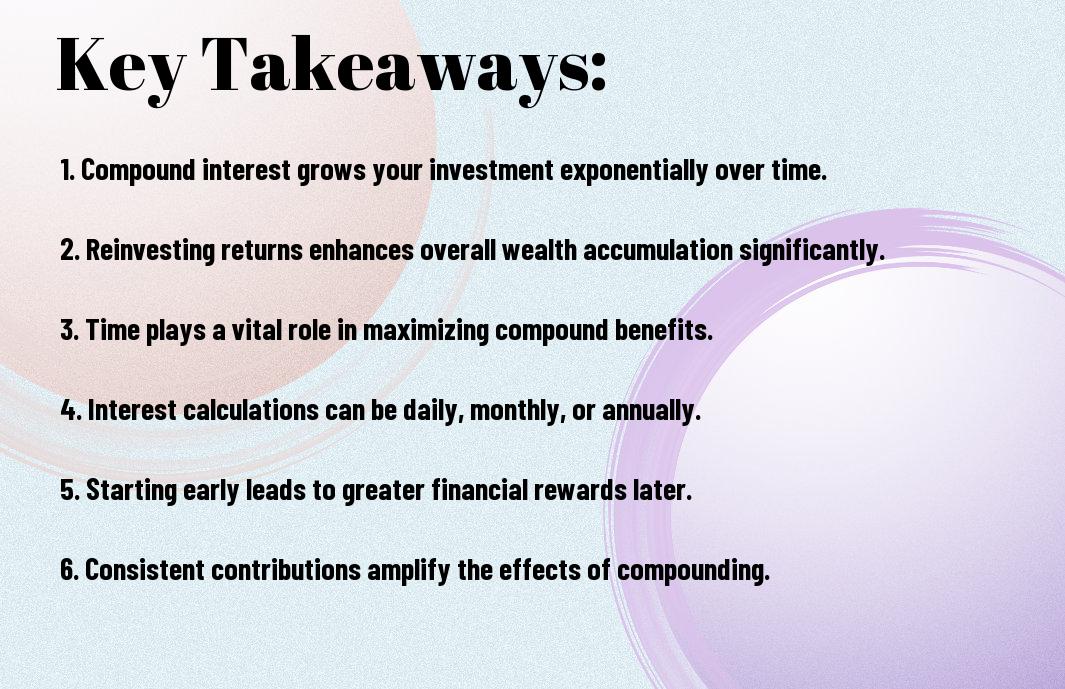Most investors overlook the significant impact that compound interest can have on their portfolio growth. By harnessing the power of compound interest, you can maximize your returns and make your money work harder for you over time. This blog post will clarify how compound interest functions, why it’s crucial for your investments, and how you can effectively leverage this concept to achieve your financial goals. Understanding this principle will empower you to make more informed decisions about your investment strategy.
Key Takeaways:
- Compound Interest enhances investment growth by earning interest on both the initial principal and accumulated interest over time.
- Time Factor is necessary; the longer the investment is held, the more pronounced the effects of compounding become.
- Frequency of Compounding plays a significant role; more frequent compounding periods (daily, monthly) can result in higher returns compared to annual compounding.
- Reinvestment Strategy involves using earned interest to purchase more of the investment, which further accelerates growth through compounding.
- Understanding Risks associated with investments is key, as higher potential returns often come with increased risk that could impact compounded growth.


The Basics of Compound Interest
Before you explore investing, it’s important to understand how compound interest can significantly impact your financial growth over time. Compound interest is where your interest earns interest, creating a snowball effect on your investment. If you want to explore more in-depth, check out How Does Compound Interest Work With Stocks?.
Definition of Compound Interest
About compound interest; it is the process where interest is calculated on the initial principal and also on the accumulated interest of previous periods. This means that as your investment grows, you earn interest on both your original amount and the interest that has been added over time.
Difference Between Simple and Compound Interest
Simple interest is calculated only on the principal amount of an investment, meaning you will receive the same interest amount in each period. This contrasts sharply with compound interest, where the interest earned in previous periods is added to the principal, leading to exponential growth.
The key distinction lies in the accumulation of interest. With simple interest, your earnings remain static since they are based solely on your initial investment. In contrast, with compound interest, your returns can increase significantly over time because each interest payment builds upon the last. This principle is particularly powerful when you allow your investments to grow for many years.
The Formula for Compound Interest
Some investors wonder how exactly compound interest works. The formula for calculating compound interest can be expressed as A = P(1 + r/n)^(nt), where A is the amount of money accumulated after n years, including interest. By utilizing this formula, you can see how your investments grow over time due to compounding. For an in-depth look at the calculations involved, check out The Power of Compound Interest: Calculations and ….
Understanding the Components of the Formula
After you familiarize yourself with the formula, it’s important to understand its components: P (the principal), r (the annual interest rate), n (the number of times that interest is compounded per year), and t (the number of years the money is invested). Each component plays a vital role in determining how much your investment will grow over time.
Examples of Compound Interest Calculations
Before plunging into specific examples, you should grasp the concept that a slight change in any of the variables can significantly impact your returns. For instance, think about how different interest rates or compounding frequencies can alter your total amount after several years of investment.
The nuances of compound interest calculations can directly affect your investment strategy. For example, if you invest $1,000 at an annual interest rate of 5%, compounded annually, in five years you would have approximately $1,276. Conversely, compounding semi-annually would yield around $1,283, demonstrating how compounding frequency influences your returns. By experimenting with different rates and periods, you can better visualize and optimize your investment potential.
The Power of Time in Compound Interest
To fully appreciate the benefit of compound interest, it is vital to recognize how time plays a significant role in investment accumulation. The longer you allow your money to grow, the more pronounced the effects of compounding become. This means that even modest initial investments can balloon into substantial sums given adequate time, making patience a key component of successful investing.
The Impact of Time on Investment Growth
Compound interest allows your investment to generate earnings not only on your initial capital but also on the interest that accumulates over time. The longer you stay invested, the more your wealth grows exponentially. For example, an investment of $1,000 at a 5% annual compounding interest rate can grow to over $1,628 in 10 years, showcasing the transformative power of time in building your wealth.
Case Studies: Long-Term vs. Short-Term Investments
One way to illustrate the benefits of long-term investing is through comparative case studies that showcase the differences in outcomes. Here’s a detailed look at two scenarios:
- Investing $1,000 in the stock market for 10 years at an average annual return of 8% results in approximately $2,158.
- Investing $1,000 in a high-yield savings account yielding 2% interest for 10 years results in about $1,219.
- If you invest the same $1,000 in the stock market for 20 years at 8%, your investment can grow to about $4,661.
- Staying in that high-yield savings account for 20 years produces around $1,640.
To effectively compare long-term and short-term investments, consider that patience can yield significantly higher returns. For instance, if you invested $10,000 in the stock market for 30 years at 8% annually, it could grow to over $100,000, whereas a short-term investment in a savings account might only total around $15,000 in the same period. This highlights how allowing your money to stay invested over time can lead to greater financial rewards, reinforcing the importance of a long-term investment strategy.
Compounding Frequency: Understanding Its Importance
For an investor, the frequency at which interest is compounded can significantly impact the growth of your investment. Compounding more frequently allows your returns to build upon each other sooner, enhancing the overall growth. Understanding how often your interest compounds can empower you to make smarter investment choices and maximize your potential gains.
Monthly vs. Annual Compounding
Monthly compounding occurs when interest is added to the principal every month, resulting in more frequent accumulation of returns. In contrast, annual compounding only adds interest once a year. Choosing investments that offer monthly compounding can boost your earnings over time, illustrating how timing in the compounding process can be beneficial.
Effect of Compounding Frequency on Returns
Frequency plays a vital role in determining the total returns on your investment. The more often interest is compounded, the greater your overall returns will be. This means that investments compounded monthly will outperform those compounded annually, even if the nominal interest rates are the same.
And by understanding this relationship, you can strategically select investment options that offer favorable compounding frequencies. Even slight differences in compounding can lead to substantial variations in your wealth accumulation over the long term. Always consider how often interest compounds when assessing your investments, as this simple factor can significantly enhance your financial outcomes.
Strategies for Maximizing Compound Interest
Many successful investors understand the power of compound interest and utilize strategies to boost its effects on their investments. By implementing various techniques like starting early and reinvesting earnings, you can effectively enhance your investment growth over time. Taking these steps can significantly increase the returns on your investment portfolio.
Starting Early: The Importance of Time
Compound interest grows exponentially over time, making the duration of your investment a critical factor. When you start investing early, your money has more time to earn interest and gain returns on those returns. This early action allows your investments to snowball, leading to a more substantial nest egg when you need it.
Reinvesting Earnings for Exponential Growth
Interest earned on your investments can be a powerful tool for generating wealth. By reinvesting your earnings, you allow your investments to grow based on the total value, including your initial capital and accrued interest. This creates a cycle of growth that compounds over time, resulting in your investments multiplying more rapidly than if you were simply withdrawing profits.
At any point in your investment journey, considering reinvestment can significantly impact your returns. When you reinvest dividends, interest, or any other earnings, you effectively increase the principal amount that earns future interest. This practice promotes a compounding effect, allowing your earnings to work harder for you, leading to potential exponential growth in your investment portfolio over the long term.
Common Misconceptions About Compound Interest
Once again, many investors fall victim to misconceptions surrounding compound interest. A common belief is that compound interest is only beneficial for long-term investments or that it only applies to high returns. In reality, even small deposits can significantly grow over time when compounded. Additionally, some think that compounding is a simple concept, overlooking its potential for powerful wealth accumulation. Understanding the nuances of compound interest is necessary for making informed investment decisions.
Myths Surrounding Compound Interest
Among the myths about compound interest, one prevalent idea is that it only benefits wealthier investors who can make large contributions. However, what truly matters is the time your money spends earning interest, rather than the initial investment amount. Some also mistakenly believe that compound interest only works in savings accounts or fixed deposits, while it can also apply to stocks, bonds, and other investment vehicles.
Truths That Every Investor Should Know
Compound interest is not just about the rate; it’s about the time and frequency of compounding. The more frequently your interest compounds, the more you earn. Additionally, investing early and letting your money grow can have an outsized impact on your portfolio’s final value. A small investment today can yield substantial returns over several decades, illustrating the power of patience and consistent saving.
Further understanding compound interest can empower your investing strategy. It’s important to not just focus on high-interest rates but also consider the compounding frequency. By making regular contributions and choosing investments that offer compounding returns, you can maximize your wealth-building potential. The earlier you start investing, the more you can benefit, as your earnings generate additional earnings, leading to exponential growth over time.
Summing up
The concept of compound interest is imperative for maximizing your investments over time. By understanding how it works, you can leverage the power of compounding to grow your wealth more effectively. The earlier you start investing and reinvesting, the more significant the impact of compound interest on your portfolio. As you continually educate yourself and apply these principles, you’ll be better equipped to make informed decisions that benefit your financial future.
Q: What is compound interest and how does it work in investing?
A: Compound interest is the process where interest is added to the principal amount of an investment, resulting in interest being calculated on the new total. This means your investment earns interest on both the initial principal and the accumulated interest from previous periods. The more frequently interest is compounded and the longer the investment period, the greater the effect of compound interest. For example, if you invest $1,000 at an annual interest rate of 5%, after one year, you’ll have $1,050. In the second year, you’ll earn interest on $1,050, not just your initial investment, which accelerates the growth of your investment over time.
Q: How can I maximize the benefits of compound interest in my investments?
A: To maximize the benefits of compound interest, consider starting to invest early, as the length of time your money is invested greatly affects the compound growth. Additionally, reinvesting any earnings or interest back into the investment will increase the principal amount earning interest. It’s also helpful to choose investment options with more frequent compounding intervals, such as monthly or quarterly, rather than annual compounding. Lastly, consistently contributing to your investment over time, rather than making one-time contributions, can further enhance the compounding effect.
Q: What are the risks associated with investments that use compound interest?
A: While compound interest can lead to significant gains, there are risks involved. Market fluctuations can affect the value of investments, especially in the stock market. A downturn may lead to loss of principal, which can reduce the amount available for compounding. Additionally, if the investment is not generating sufficient interest to outpace inflation, the real value of your returns could diminish over time. Lastly, some investments may have fees that can erode earnings, so it’s important to assess the terms of any investment for potential costs involved.

